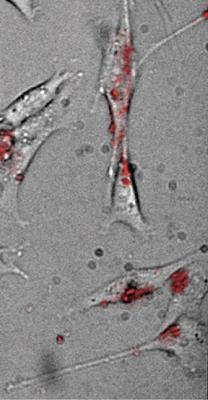Researchers, Liwei Lin of the University California-Berkeley and Haw Yang of Princeton University, have utilized a novel device called nano-thermometers to measure the individual cell temperatures inside the human body.
 Researchers are using quantum dots (shown in red) to take the temperature of living cells.
Researchers are using quantum dots (shown in red) to take the temperature of living cells.
The researchers have also observed that the temperatures of individual cells do not match with the normal 98.6 °F. Yang stated that his team has utilized selenium and cadmium quantum dots, which emit various colors of light depending on the temperature value. During a chemical reaction, temperature is one of the most critical physical factors that can alter, he said. Hence, his team actually sought to understand the chemical reaction within a cell, which in turn reveals more about the chemistry of life, he added.
During the study, the scientists placed the nano-thermometers inside mouse cells developed in the laboratory dishes. They observed temperature variances between the cells, with portions of the cells both cooler and warmer than other cells. However, they could not measure the temperature accurately to figure out a numerical value. They also deliberately activated cells to trigger biochemical actions inside cells and recorded the corresponding temperature changes.
Yang said that these temperature alterations could lead to body-wide impacts in identifying diseases and health. The temperature changes may affect the genes’ work by altering the normal functions of its parent material DNA as well as the function of the protein molecular machines, as certain proteins may stop production by becoming denatured due to higher temperatures.
Yang further said that his team is the first to demonstrate that temperature responses within individual living cells are different. This finding directs them to their next hypothesis that the cells use the temperature differences as a means to communicate, he said. His team is now carrying out research to identify the cause that regulates the temperature of individual cells.